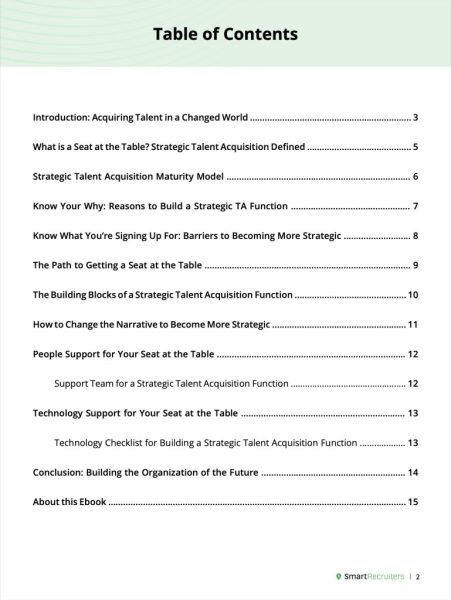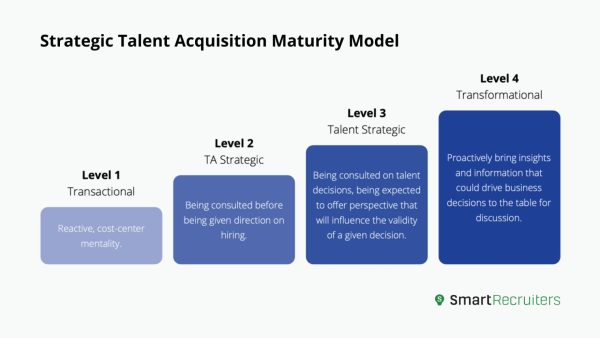In the post-pandemic world, the rules of hiring fundamentally changed—along with the expectations for talent acquisition. When businesses struggled to hire during the rebound from the pandemic cutbacks, the star of talent acquisition rose from its historical position as a cost center in many organizations. Talent acquisition had its seat at the proverbial table, but when recession fears took hold, TA lost its place amidst layoffs and hiring freezes at some companies.
Talent needs to be center stage for businesses to adapt and thrive in 2023 and beyond. To do this, talent acquisition needs to maintain its seat at the table—or step up if it hasn’t already. Trends like flexible work, DEIB, and workplace automation have all made employers think differently about who and how they hire.
A cost center that speaks in the language of speed and efficiency does not offer the strategic perspective organizations need to hire effectively amidst rapidly changing employee and candidate expectations. When talent acquisition earn a seat at the table for strategic talent decisions, businesses are more likely to reach their full potential.
According to the Josh Bersin Company, companies that leverage the right recruiting strategies are
- 5X more likely to delight customers
- 30X more likely to engage and retain employees
- 35X more likely to innovate effectively.
Leveraging the right recruiting strategies is not just the job of talent acquisition teams; it’s a job for the whole organization.
A Seat at the Table Defined
Allyn Bailey, Executive Director of Hiring Success Services at SmartRecruiters, has spent decades at the forefront of global talent acquisition. In our latest ebook, A Seat at the Table: A Guide to Leading a Strategic Talent Acquisition Function, Allyn says,
“Having a seat at the table means not just being involved in decisions directly related to talent acquisition, it means providing input into all decisions that have a talent lens to them.”
If a talent acquisition leader wants to get a seat at the table, they must move from the perception of their function as a cost center to a strategic function. Allyn says,
“A strategic TA leader is a trusted partner who can come to the table with information that tells business leaders what’s happening in the market, what’s realistic to assume, and how their decisions will impact the company’s ability to capture and keep talent.”
The journey to becoming a strategic leader—someone who gets invited to meetings because it’s widely known that they have valuable information and perspective that can help the business make high-priority decisions—is varied and complex. It requires that a leader shift their mindset from being an order-taker to someone who provides data-backed insights.
Leading a strategic talent acquisition function is not always easy. Allyn asked, “If you don’t have a seat at the table today, why not?” The reasons could be a blend of personal and organizational factors. She recommends that leaders get clear about why they want that seat and what they might do with it once they get there.
To help leaders along this journey, we spent hours interviewing Allyn and two members of SmartRecruiters’ Hiring Success team: Dave Novak, Engagement Manager, and Jared Best, Regional Practice Leader. In those conversations, we uncovered a path for leaders to become more strategic and get the seat at the table they deserve. Our insights are condensed into the ebook A Seat at the Table: A Guide to Leading a Strategic Talent Acquisition Function.
 Below we list highlights from key sections of the ebook:
Below we list highlights from key sections of the ebook:
Strategic Talent Acquisition Maturity Model
For each level shown in the maturity model above, the ebook offers example scenarios so that you can assess your company and start forming your own North Star vision. To get a real-world picture of how one organization moved to greater maturity, read The Incremental Journey to Talent Acquisition Transformation at Colliers EMEA.
Know Your Why: Reasons to Build a Strategic TA Function
The benefits of getting a seat at the table fall into three areas: to help your organization, support your team, and grow your own career. We expand on each of these areas and provide reflection activities in the ebook so that you can move ahead with inner confidence.
Know What You’re Signing Up For: Barriers to Becoming More Strategic
In our discovery conversation, Allyn Bailey said, “Leaders need to assess their organization’s ability to absorb them into the conversation.” She spoke of the time it takes for organizations to change and said, “Pay attention to the signals that you’re making traction. People will be asking smarter questions and start to repeat words that you’ve inserted into the conversation and adopting them as their own.”
The ebook lists eight common barriers with potential solutions and includes a reflection activity for your company’s situation. For inspiration, read our success story with KinCare which describes the growth of organizational trust after the implementation of SmartRecruiters.
The Path to Getting a Seat at the Table
Our Hiring Success experts have observed many organizations going through the stages of building a strategic function. We can’t emphasize enough that it’s not just a shift for the individual leader; it’s a shift for the whole organization, and it requires many conversations. This section outlines six stages that you can expect to go through.
The Building Blocks of a Strategic Talent Acquisition Function
A strategic TA leader oversees seven critical components of talent acquisition. Your company may be more invested in some than others. Here you’ll find a list of signs of under-investment and high investment. Looking at the list can help you get clear on where you need to start so that you can generate a small win and develop a plan to address larger issues.
How to Change the Narrative to Become More Strategic
Being perceived differently means talking about different things. In the case of talent acquisition, it means understanding what the business cares about and bringing valuable information to the table. “The biggest thing a leader can do is change the narrative,” said Jared Best. “Move away from talking about transactional data and focus on data that ties back to organizational objectives.” This section offers three strategies to do just that, plus a reflection activity.
People Support for Your Seat at the Table
As a strategic leader, you will need the help of not only your team but also others within the organization. Here you’ll find a list of 10 key roles on your support team and their responsibilities.
Technology Support for Your Seat at the Table
Your recruiting tech stack may or may not be optimally configured to support your strategic priorities. To help you clarify what technology concerns you may need to address, we created an 8-point technology checklist for building a strategic talent acquisition function.
We’d love to say that there’s a magic wand you can wave and have a perfectly functioning TA team that attracts and hires the best candidates, facilitates recruiter productivity, and engages hiring managers—while increasing employee retention and profits. Instead, we live in a complex reality, and we hope this guide will be one resource to help you get to where you want to go.








